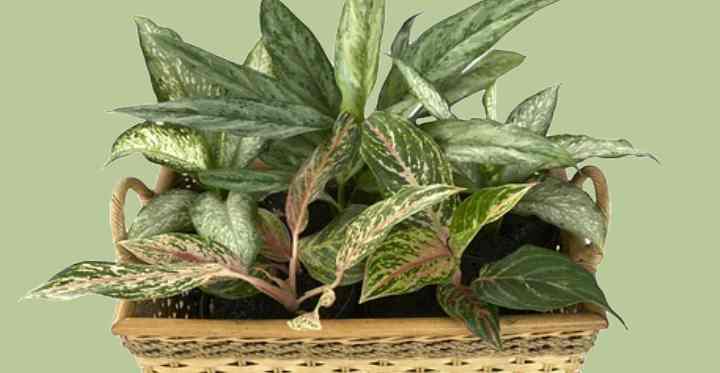A group of flowering tropical plants with beautifully patterned leaves is known as Chinese evergreen plants (Aglaonema). At home, Aglaonema plants are simple to cultivate, and their vibrant leaves brighten up shaded rooms. Pink, silver, red, yellow, or orange designs may be seen on glossy green leaves of certain Chinese evergreen species. Spathe-like blooms, similar to those seen on other aroids like anthurium plants, may occasionally bloom indoors.
How to care for Aglaonema plants: Chinese evergreens thrive in moist potting soil and medium to high humidity, and grow in bright to low light. Only water the plant when the top 1″ (2.5 cm) of soil is dry. During the growing season, maintain temperatures of 65°F to 80°F (18°C to 26°C) and fertilize every month.
The plant family Araceae is home to the aglaonema houseplants. These plants, which are native to Asia and grow upright or creepers stems, vary depending on the species. Chinese evergreens grow slowly in tropical and sub-tropical rainforests and prefer shaded circumstances.
Mature Aglaonema plants grow to be 1 to 4 feet (30 to 120 cm) in height when grown indoors in pots. Many people grow Chinese evergreen houseplants as decorative plants. Long, 12-inch (30-cm) leaves and a silvery green color are characteristics of the cultivar known as the ‘Silver Queen.
Aglaonema plants bloom indoors and the blooms may last for several months in ideal circumstances. Yet, it is the vibrant foliage of these plants that makes them appealing indoor plants.
Types of Aglaonema (Chinese Evergreen)
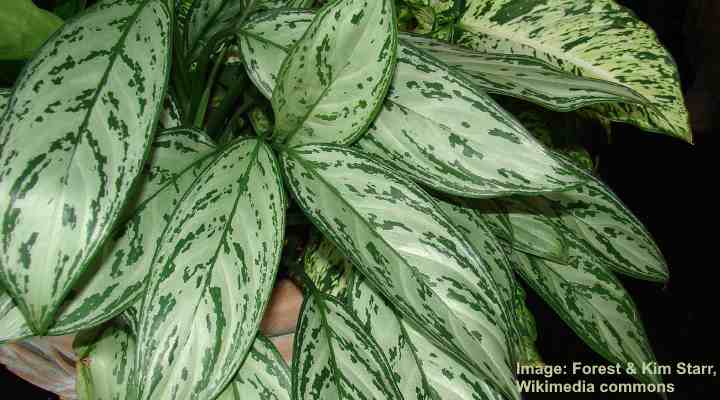
The most common cultivar of aglaonema houseplant is Aglaonema commutatum ‘Silver Queen,’ which has silver-white leaves. For example, consider the following:
- Aglaonema ‘Silver Queen’—This species has lovely silver-gray and green variegated leaves that are also known as the “painted drop tongue.”
- Aglaonema ‘White Calcite’—Lance-shaped green leaves with white markings make up the stunning foliage of this houseplant.
- Aglaonema ‘Siam Aurora’—This red Aglaonema has pointed glossy-green leaves with black red margins and veins.
- Aglaonema ‘Anyanmanee’—This is another kind of red Aglaonema with variegated leaves that are dusty pink and green.
- Aglaonema ‘Pink Dalmatian’—This Chinese evergreen cultivar has delicate pink spots and speckles on its dark green leaves.
- Aglaonema ‘Red Emerald’—The dark green leaves of this gorgeous houseplant have crimson streaks and amber lines.
- Aglaonema ‘Silver Bay’—This Chinese evergreen has silvery foliage that is brightly colored and dazzling. It will complement any indoor décor.
Chinese Evergreen Flowers
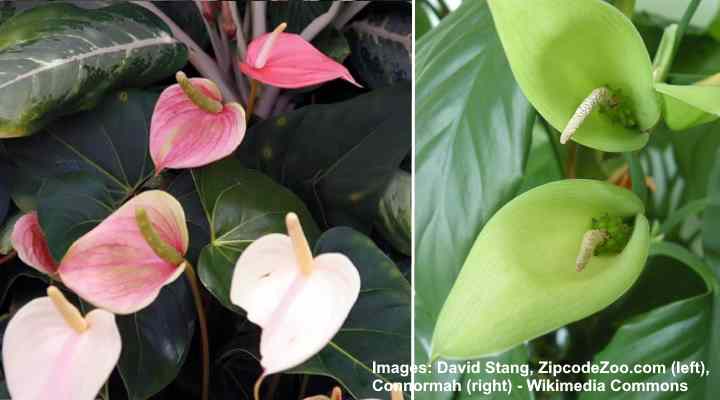
Aglaonema plants bear blooms that are similar to those seen on other aroid species, such as anthurium species. If the environment is correct, aglaonemas may bloom indoors. A colored spathe, or modified leaf, and a spadix, or flowering spike, make up the flowers. The blossoms are usually white or light green in color. The foliage on these plants makes them appealing, and the Chinese evergreen blooms aren’t particularly showy.
How to Care for Chinese Evergreen (Aglaonema)
Many people believe that Aglaonema is a plant associated with luck. Nonetheless, looking after these plants at home does not come with any luck. Some of the easiest houseplants to maintain are Chinese evergreens.
How Much Light Does Aglaonema Need?

Chinese evergreen plants thrive in most indoor lighting conditions, and Aglaonema ‘Siam Aurora’ is one of them. Several types of Aglaonema plants may thrive in environments with almost no illumination. To keep their foliage vibrant, other plant cultivars need brighter light. The plant’s protection from direct sunlight is the most important light requirement.
The dark-leafed types of low-light plants in the Aglaonema genus are the best. Dark, glossy green leaves, for example, can be found on the ‘Pink Dalmation,’ ‘Red Emerald,’ and ‘Modestum. In dark rooms like bedrooms or poorly-illuminated bathrooms, these indoor plants may thrive. In brighter settings, however, they can also flourish.
Bright light is required for the majority of the Aglaonema cultivars with brilliant silver, red, or pink foliage. In the morning, choose a spot with direct sunlight, and in the afternoon and evening, pick a spot with indirect sunlight. ‘Two-Tone Moonstone,’ ‘White Calcite,’ ‘Silver Queen,’ and ‘Golden Fluorite are the best Chinese evergreens for bright locations.
The location may influence additional care requirements depending on where you position the potted Chinese evergreen. The plant, for example, will develop quicker in a bright area and may need more watering and feeding. You will have to water less often in a dark location, however.
The Best Potting Mix for Chinese Evergreen
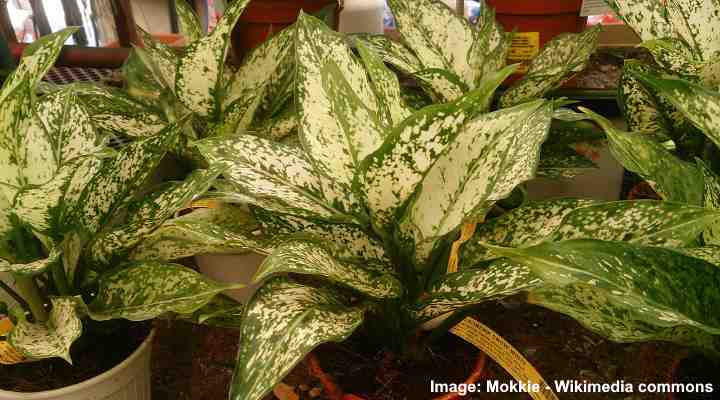
Aglaonema ‘Snow White’ is a cultivar that thrives in a light, well-draining, mildly acidic potting media. To avoid roots from becoming soggy and mushy, the loose soil must allow excess water to drain rapidly. A peat-based potting soil with perlite to improve drainage is a good choice for growing Chinese evergreens.
For Chinese evergreens, the ideal potting soil should Provide just enough moisture to keep it fresh. You may additionally add pumice or orchid bark to increase drainage, in addition to perlite. When tropical houseplants’ roots grow in overly moist soil, the worst thing that can happen to them is
The quickest way to tell if you have the proper potting soil is by how quickly it drains. The presence of puddles on the soil surface indicates that the growing medium is too thick and heavy. The plant might be rootbound, which is another possibility. A fresh potting soil with excellent drainage is required for repotting the Chinese evergreen.
How to Water Chinese Evergreen Indoors

Water Aglaonema plants as frequently as the top section of the soil dries out, because this picture shows it with its gorgeous red and green leaves. The climate, sort of soil, and pot all impact the frequency of watering Chinese evergreens. You’ll have to watering the plant more often in the spring and summer than in the fall and winter.
Before watering, wait until the soil is between 1 inch to 2 inches (2.5 cm) dry. Soak the soil well before watering the plant to ensure that the roots are adequately hydrated. The drainage holes should be watered sufficiently to allow excess water to drain away. Before watering, wait until the soil has dried somewhat further.
Watering houseplants on a set schedule is one of the most common mistakes made. Overwatering is a problem that may lead to your plant dying if this strategy is used. Insert your finger into the soil to detect when it’s time to water an Aglaonema plant. It’s time to water the soil if it’s dry.
Chinese Evergreen Growth Rate

Aglaonema plants are typically tropical plants that grow at a sluggish to medium pace. Some species, on the other hand, may grow more quickly than others. Chinese evergreens, for example, grow slower in winter and in low-light rooms, such as the silver bay ‘Siam Aurora.’
Temperature Requirements for Growing Chinese Evergreen
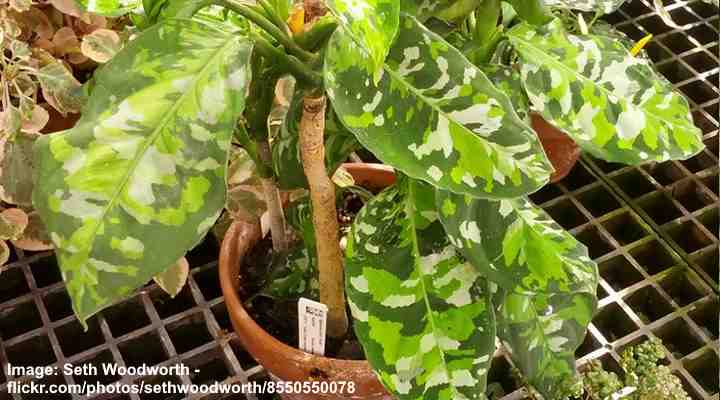
Because they thrive in room temperature, Aglaonema pictum ‘tricolor’ has a stunning leaf pattern that changes colors. Between 65°F and 80°F (18°C and 26°C) is optimum for Chinese evergreens. If left below 60°F (15°C), Aglaonema will begin to perish. Your houseplants will feel comfortable in most situations if you feel so.
You should avoid temperature extremes when growing tropical houseplants indoors. Therefore, avoid exposing the plant pots to high temperatures or sharp changes in temperature. Don’t expose the plant to chilly breezes or air conditioning drafts in the summer. Avoid placing your plant near a hot radiator during the winter.
If you live in a climate with warm temperatures, you can grow Chinese evergreen outdoors. USDA zones 10 and 11 are home to the aglaonema plants. Take your plants outside in the summer if you live in temperate areas. On a patio, balcony, or deck that is shaded from direct sunlight, locate a bright spot. When the temperature drops below 65°F (18°C), bring the plant inside.
Indoor Aglaonema Plants – Humidity

Most Chinese evergreen species prefer moderate humidity levels. Nevertheless, like in their natural habitats, the growth of Aglaonema cultivars requires high humidity levels in the air. They should ideally be kept at a humidity level of at least 50%. Maintain these wet, leafy plants in a humidifying tray or mist them several times a week to meet their humidity requirements. How can you humidify Chinese evergreen plants in the most effective manner? Here are a few suggestions to get you started:
- Misting—Create a fine mist above the leaves with a spray bottle filled with filtered or distilled water. Directly spraying water onto the leaves is not recommended.
- Humidifying tray—By using a humidity tray, you can increase humidity in the plant pot. This can be achieved by placing a layer of decorative pebbles in the bottom of a big dish. Fill halfway up the stones with water. Place the container on the pebbles.
- Humidifier—If you want to maintain humidity above 50%, you may use a humidifier for several tropical plants indoors.
One indication that humidity is needed is brown tips on the leaves. You should usually mist the leaves and water them less often in the winter. Dry air is a common result of home heating, which makes caring for plants indoors difficult. Evergreen tip: Evergreen plants are ideal for bathrooms because they thrive in dim rooms with high humidity.
Fertilizing Chinese Evergreen Plants

Slow-growing aglaonema plants don’t need a lot of attention. Typically, a basic houseplant fertilizer at half-strength provides enough minerals and nutrients for robust development. Only fertilize the Chinese evergreen tree monthly, if at all, throughout the growing season. When it comes to feeding, here are a few tips to keep in mind: 1.
- Over-fertilizing—Root burn can result from feeding too often or with undiluted fertilizer. Mineral salts may even accumulate to the point that your plant’s development slows. The stems and leaves are also starting to droop, which you may notice.
- Seasonal requirements—Only in the spring and summer do aglaonemas require fertilization. During the winter months, when development is slowed, refrain from providing food.
- Soil flush—Soil flushing is beneficial to your plant once or twice throughout the growing season. Excess minerals that may build up in the soil can be flushed out by briefly watering the soil.
How to Prune Aglaonema
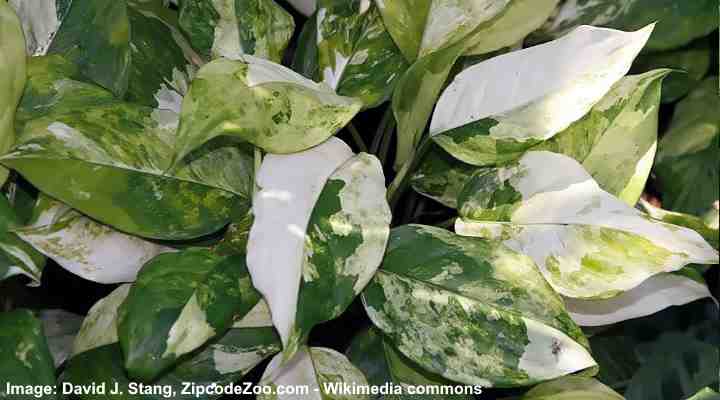
Trimming a Chinese evergreen to encourage faster development, produce a bushy houseplant, and remove dead foliage is helpful with Aglaonema modestum ‘Variegatum’. Pruning is seldom needed because nearly all types of Aglaonema plants have robust development.
According to some houseplant specialists, pruning the plant causes new growth from the crown, which is why it should not be done. Prune away dead leaves or leaves with brown tips if it is essential to chop back a Chinese evergreen. Cut the stem protruding from the earth just above where the leaves are trimmed.
When aglaonema plants bloom, it’s another good reason to trim them. In the spring, your plant will create blossoms if it blooms. The flowers, on the other hand, are small and unappealing. By removing the flowers, you direct energy to the plant’s foliage, which improves its appearance.
Aglaonema Propagation

Root division is the most effective way to grow Chinese evergreens. When you repot the plant every other spring, is the optimum time to split the roots. All you have to do is cut a section of the root with a few healthy stalks. Plant the new seed in a tiny pot with the proper kind of growing medium.
How to Repot Chinese Evergreen Plants
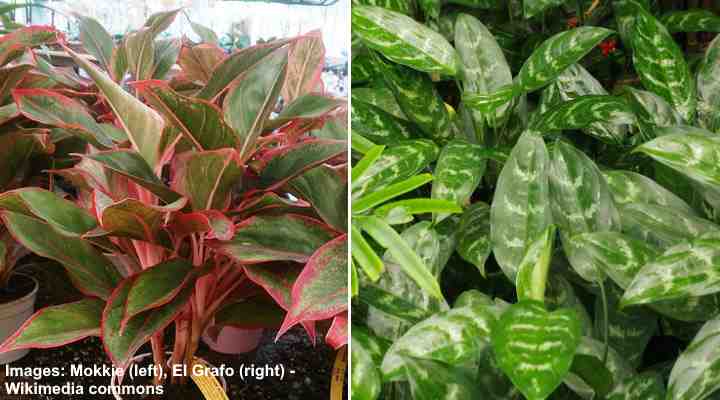
You may only repot Aglaonema cultivars every second year due to their medium to slow growth. The best time to transfer is in the spring, when the plant is growing vigorously. Checking for root rot and replenishing the soil are both benefits of repotting Chinese evergreens.
Replanting in a fresh pot also aids in better development. The roots expand as they grow, occupying more space in the pot. The roots have more space to develop when you choose a new pot one or two sizes bigger. While repotting, you may clip around one-third of the roots to prevent plant development. The procedures for repotting Aglaonema species are as follows:
- Remove the plant and root ball from its existing container gently.
- If necessary, clean the roots and untangle them.
- Check for soft brown roots and cut them away with clean instruments.
- Plant the plant in a new container that has been half-filled with suitable potting soil.
- Leave roughly 1″ (2.5 cm) of space above the top of the pot for the remaining area to be filled with potting mix.
- Pour in a good location with plenty of water.
Top growing tip: Always pick a container with a large drainage hole in the bottom.
Pests and Diseases Affecting Aglaonema Growth
Mealybugs and scale are the most common pests that affect Chinese evergreens. Wilting growth and eventual death can occur if you have sap-sucking houseplant nuisances. Aphids and spider mites may attack Aglaonema plants at times.
The plant can be afflicted by fungal or bacterial infections. Proper watering, on the other hand, tends to avoid such issues. When you notice signs of houseplant pests, act swiftly! To try to get rid of the plant bugs, you may use insecticidal soap. Please read this article on how to eliminate homeplant pests naturally for further tips.
It may be difficult to get rid of plant diseases. Plant disease can be avoided altogether if you prevent it from occurring in the first place. Therefore, between watering, always allow the soil to dry somewhat. This avoids bacterial or fungal infections from developing around the plant’s roots and prevents soil from becoming waterlogged.
Are Aglaonema Plants Toxic?
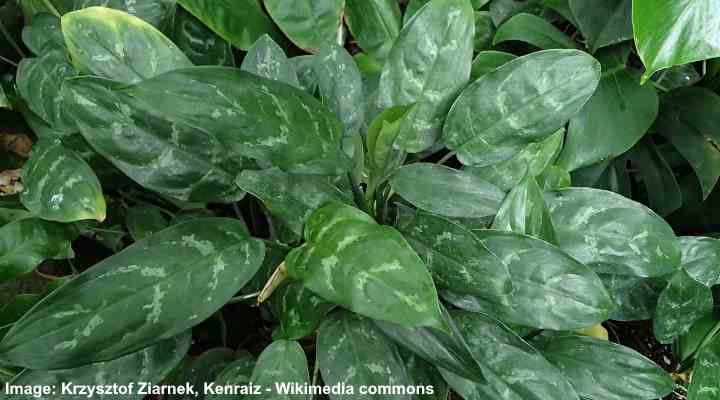
Commutatum is a variety of Aglaonema. Aglaonema plants are listed as poisonous plants that may kill animals and people, according to the US Food and Drug Administration. Calcium oxalate crystals may cause irritation and burning in Chinese evergreen plants. Never consume the plants, and handle them with care.
Touching the sap of Aglaonema plants may cause a rash, according to experts. Additionally, ingesting portions of the plant may cause significant oral discomfort. As a result, keep children away from the plants. According to the ASPCA, dogs, cats, and horses are poisonous to Aglaonema plants. Pain, swelling of the lips, abnormal drooling, and vomiting are all indications of poisoning.
FAQs about Growing Aglaonema (Chinese Evergreen)
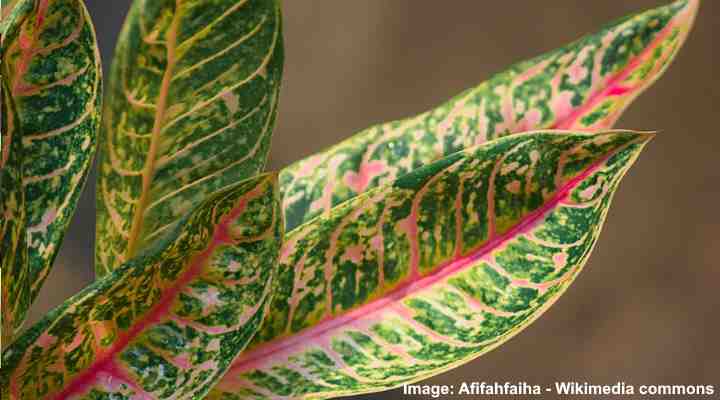
Do Chinese evergreen plants improve air quality?
Plants with air-filtering capabilities are thought to exist within the genus Aglaonema. NASA studies identified Chinese evergreen plants as having the potential to remove harmful pollutants from the air. Benzene, formaldehyde, and xylene were among the chemicals listed.
Why are the leaves on my Chinese evergreen turning yellow?
Incorrect watering, particularly excessive water, can cause aglaonema leaves to turn yellow. Check the soil for moisture and adjust your watering schedule appropriately if you notice that many leaves are starting to yellow. Your Chinese evergreen may be lacking in copper if you are watering correctly.
Why does my Aglaonema have drooping leaves?
Your plant may be in direct sunlight if the red, yellow, pink, or variegated Chinese evergreen leaves are droopy. The wilting leaves have also curled up to protect themselves from the sun, which you may notice. Because of a lack of bright light, some lighter-leafed Aglaonema species may have drooping leaves.
